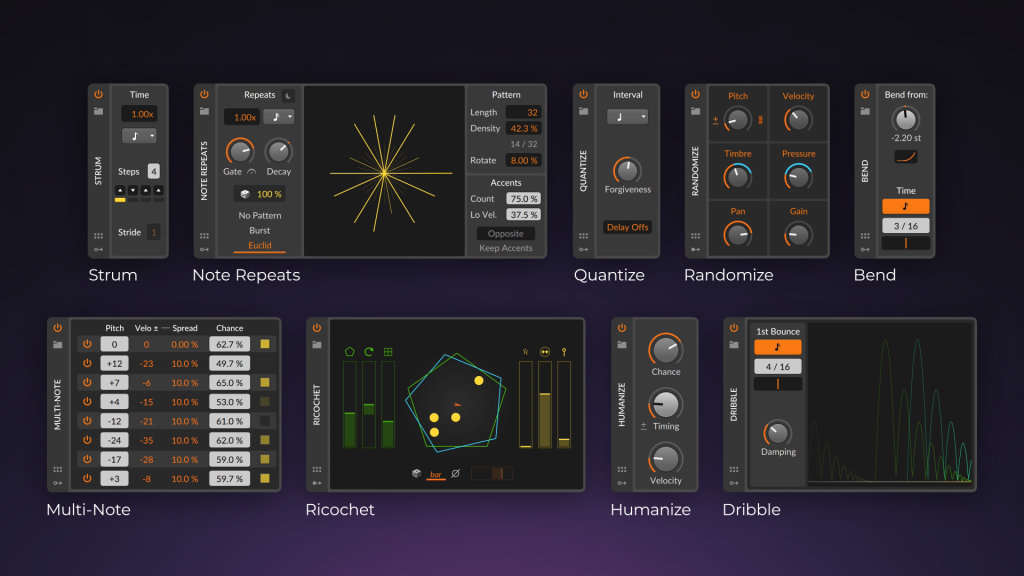Bitwig users get a bunch of goodies in the just-announced 4.1. There are tons of Note FX devices with various features for organic and musical and simulated physics-based playability, plus a really smart way of handling color palettes, chains that trigger when you release Sampler notes, and more.

She’s like a rainbow
If you’re on Bitwig’s newsletter, you know about the notes thing, so let me talk about the feature that isn’t a headline that excites me. Yeah, all the music software lets you color-code your tracks, but it usually comes up with some puke-rainbow of chaos. So I love this, aesthetically:
Bitwig Studio 4.1 extends color palettes to clips and layers, and you can make your own by dropping a JPG or PNG into the Bitwig Studio window. Does that mean I’ll start using Adobe Color with my sessions? Well, yep.
Note FX
Count them – 21 new note processors:
The quick rundown:

- Humanize (which also includes probability)
- Quantize with “forgiveness” which sets a threshold to let some material go unquantized – a nice approach (see also video below)
- Ricochet is a bounce/collide physics-based processor with both stereo spatizliation and timbre control
- Dribble is another bouncing thing, closer to more of the other bouncey stuff you may have seen – an incoming trigger makes a bunch of bouncing-ball stuff happen after. The smart twist here is “damping.”
- Randomize is assignable to parameters – but it works with note expression, and it works with MPE. Now we’re talking.
- Strum we’ve seen in forms before as I said in M4L and Maschine, but here is another nice implementation – and it pairs well with the others.
- Bend is a more nuanced take on glide/portamento, but works relatively and integrates nicely with Instrument Layers.
- Note Repeats is what you think it is – a retrigger. But it has a number of smart twists – an option for Euclidean repeats (never seen that before in this combination), a Disable that leaves currently-repeating notes going rather than killing the whole device (ideal for playing live),
Honestly, the “forgiveness” parameter with quantize I think is essential. It really gets to “the heart of the matter.” Even if, even if I don’t have chops any more. (Come on, you don’t think I’d control my attention deficit through a story on a DAW update, did you? I’m learning to live without doing everything in Live… I missed you sometimes, Bitwig. I’ll be here all night.)
Sampler Release chain and more
There are a number of other features, but the other one I find interesting is putting a Release chain in Sampler – so when you release a note, it triggers an instrument. That works with samples that contain that information already (SFZ), but it could also be a way of building complex playable sounds.
The rest:
- Updated Multi-Note, Note Length, Note Filter Note FX, too
- Direct MIDI output from all tracks (but still HW Instrument if you need delay compensation)
- Updated presets with more consistent velocity, vibrato mappings
- Arpeggiator updated with Update Rate at Next Step (oh, yeah, that’s useful when switching rates)
- VST3 IMidiLearn support
- More features in Controller API (Arranger loop range, cue marker add and remove, expand/collapse group tracks, canUndo, canRedo)
- Lots of fixes
- More
The best of times is now
We’re definitely seeing one of those mature cycles of DAWs – even the younger ones like Bitwig Studio – where it’s not so much about entirely new ideas as everybody trying to perfect execution. And I’m okay with that. So these Note FX do incorporate ideas you’ve seen elsewhere. There’s strumming like we saw on Maschine and later in Max for Live, and some resonance with stuff like the Inspired by Nature series by Dillon Bastan.
But let’s reflect on this a bit. For full decades, leapfrogging in music software was focused on pretty mouse-heavy edit features and lots of sequencing and editing devices that kept you on the grid – both the pitch and rhythmic grid, in a way that distorts even western concert music to say nothing of other traditions.
Now, I think we’re in a pretty nice phase, where the competition is getting software makers to get more creative and nuanced with off-the-grid, imaginative, inspirational devices.
And there are some delightful details to these. It makes sense, too, because we had years of ever-more-sophisticated, modular synths but kept triggering them with the same quantized 8-step patterns on, like, the note C. So bring it on.
More inspiration wanted? Teleport yourself to Superbooth back in September:
Out in Beta now.
https://www.bitwig.com/whats-new/


